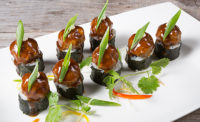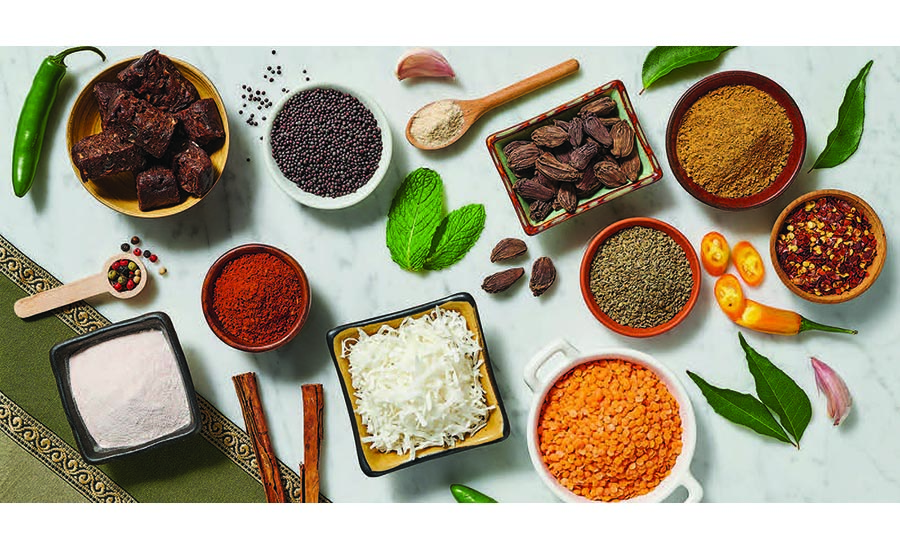2021 Predictions: FLAVORS, SPICES & SEASONINGS
Flavored Nation
It’s all about flavor. That truth may be self-evident, yet it’s never been more manifest.

Food Trends get more diverse and more global each year, but with 200 countries and thousands of culinary regions, new flavors and fusions continue to appear.
PHOTO COURTESY OF: WIXON, INC. (WWW.WIXON.COM)

Consumers attracted to the flavor flair and zing of Korean BBQ and other Korean foods, sauces, and condiments.
PHOTO: MCCORMICK FLAVOR SOLUTIONS (WWW.MCCORMICKFLAVOR.COM)


WITH THE RECENT jump in home cooking, the role of flavor has been especially magnified as food serves a magnified role in providing excitement, comfort, health, indulgence, self-care, and family bonding. All this means a new spice boom in 2021. Spice manufacturers have seen a dramatic spike in demand for their products.
According to consumer research group NPD, the national consumption of spices, seasonings, marinades, and rubs was up more than 50% over the previous year. This opened the door for some exotic, intriguing flavorings and new versions or formats of familiar ones.
One example is black cocoa powder. Darker in color and stronger in flavor, it’s exotic without being too challenging. Black cocoa offers safe excitement, i.e., consumers feel comfortable going to the next level with something familiar and beloved like cocoa.
Since global travel was “out” for most of 2020, global ingredients became more “in” than ever, and that will carry into the new year even if travel picks up again. Consumer attraction to trans-cuisine ingredients also is more intense and adventurous. Broad geographic influences are embodied in spice blends that represent a specific cuisine or ethnicity—or a pairing of them.
The booming trends of the last few years, which have been moving into mainstream and home cooking, include harissa (sometimes called Tunisian chili paste), the blend of North African spices and red peppers or tomatoes; Moroccan classic ras el hanout; za’atar, a mix of dried Middle Eastern herbs and spices; and Peruvian yellow pepper ají amarillo.
New for the coming year will be more ready meals and prepared products featuring these exotic flavor blends, as well as the possibility of cultural cross-pollination as some of them might try a merger with, for example, a hot yellow pepper harissa.
SMOKE GETS IN YOUR EYES
Smoke has been getting a lot of attention from chefs — and not just for barbecue. The aroma of smoke and the primal nature of smoky flavor hold a place deep in the human psyche. Last year’s big splash by artisanal smoked salts is expanding into such flavorings as smoked spices and even smoked sugars. In the coming year, we’ll see more smoke in the form of such items as lightly smoked butters, tofu, and fruit. Smoke will be used in vegetables to pump up the umami in plant-based meals, much as roasting does. And, if you’re reading tea leaves for 2021, you’ll find hojicha, a trending, low-caffeine, roasted Japanese green tea praised for its smoky flavor and earthy aroma. With similar teas like Darjeeling and Lapsang Souchong already widely available, expect to see smoked teas being used as flavor infusions in products other than beverages soon.
WAY OUT EAST
Earlier, we reported on trends in flavors from the Far East that showed signs of coming onto the flavor radar. One that showed promise was shichimi, a Japanese seven-spice blend, and while it’s not yet a hot trend, it has been making its way into the interior of the country from the coasts.
Quite the opposite, however, has happened with that triumvirate of Korean favorites, kimchi (fermented garlic, cabbage, and chili paste), Korean BBQ, and gochujang, a paste of fermented sweet rice and red chili. Those intoxicating flavor platforms took off like a shot. Their popularity speaks to the explosive consumer insistence on ever more blended spices with flair and zing.
Meanwhile, with the Nashville Hot Chicken trend shifting from restaurants to prepared foods, Korean fried chicken is on its way to being the next big hot thing. More like a chicken fritter, in its most popular form the chicken is coated with sugar, soy sauce, ginger, toasted sesame oil, and fermented chili paste, then deep-fried twice. Served as a snack or appetizer, it can readily translate to batch production and be made to freeze well.
Also, Cambodian cuisine is emerging here, so keep an eye out for tuk meric, a lime and black pepper sauce, and kroeung prawlak, also known as Cambodian barbecue paste, created by Angkor Cambodian Food Co. and based on traditional street food flavors. Its base is lemongrass, onion, and garlic with chili peppers and sugar to hit all the flavor points of the palate at once. Tamarind, lime, lemongrass, and galangal will ride the Southeast Asian revival and could become dominant flavors in other culinary fusions as well.
HEALTHY FLAVORS
Sea buckthorn could be the turmeric of 2021. This North Eurasian yellow berry has been skirting the edges of trendiness for a couple of years now and has started appearing in more foods and beverages. It tastes sweet and sour with a hint of tropical fruit and is an intense source of vitamin C as well as antioxidants that counteract the free radicals that damage DNA.
Sea buckthorn also contains high concentrations of omega-7 fatty acids. That’s not a misprint; while omegas 3, 6, and 9 have been drawing all the attention, the uncommon omega-7 has demonstrated an ability to reduce inflammation and lower insulin resistance. Speaking of yellow berries, Inca berries — also called golden berries, cape gooseberries, or choke cherries — are small, tart, golden relatives of tomatillos that also deliver a sweet-tart and juicy burst of flavor alongside high doses of vitamin C. They’re also high in vitamins A and B3 as well and, for a berry, contain a surprising amount of protein.
True gooseberries haven’t been popular since Grandma baked them into pies a couple of generations ago. But with tarter flavors finding more favor with the American palate, the healthy little gems in green, red, and purple could start popping up with greater frequency in pastries and confections as well as sauces and jams. Like sea buckthorn, they’re a source of omega fatty acids and lots of fiber and vitamin C.
Food and health have merged as never before after a stressful year that necessitated more cooking and eating at home. Experts see this extending beyond current events, however, and point to increased consumer demand for healthy convenience, greater ease of preparation, and lots of new and intense flavors to bring it all together.
Looking for a reprint of this article?
From high-res PDFs to custom plaques, order your copy today!








